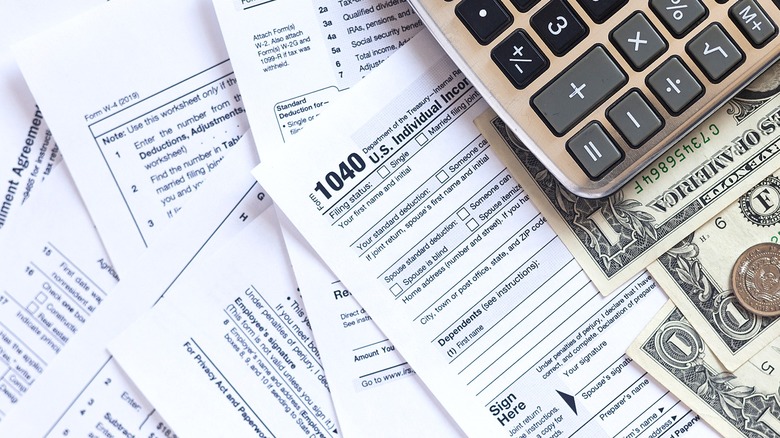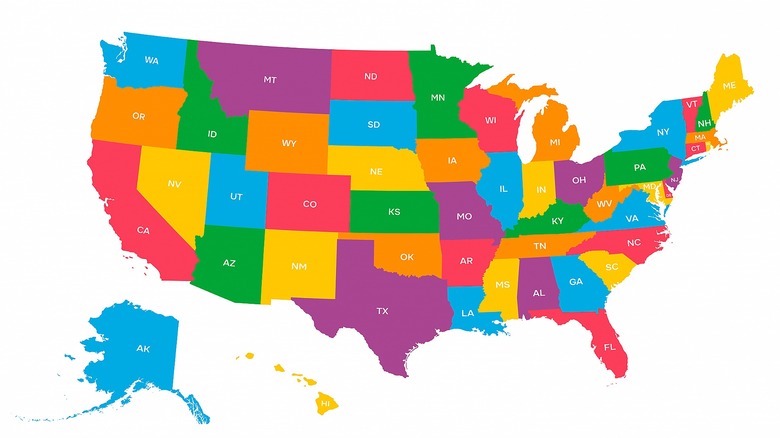The Simple Way To Tell Which Federal Tax Bracket You're In
As you prepare to file your income taxes by the deadline, you likely are thinking about a number of things, including whether or not you'll get a refund this year, and if you do, what you should do with it (Hint: Don't splurge your refund). Another number you should be aware of is your tax bracket, or where your taxable income falls within the federal tax system. There are currently seven tax brackets in the United States' graduated tax structure, with each bracket (or tax rate) corresponding to a range of incomes based on filing status: 10%, 12%, 22%, 24%, 32%, 35%, or 37%.
Once you determine your taxable income, you can figure out what your tax bracket is by looking it up on a chart, like this one from the Tax Foundation for tax year 2023. For instance, if an individual tax filer has a taxable income of $80,000, they'd fall in the 22% bracket, which, to be more precise is their marginal tax rate. This refers to the highest tax rate applied to the person's taxable income, but only for the portion of the income that falls within the income range for that bracket.
In the case of $80,000, for a single filer, any taxable income above $44,725 and below $95,375 will be taxed at 22%. The portion of the person's income below $44,725 and above $11,000 will be taxed at 12% and the portion up to $11,000 will be taxed at 10%. This being said, if someone were to ask you what tax bracket you're in, your answer would simply be your marginal tax rate.
Tax bracket vs. effective tax rate
For the seven tax brackets or marginal tax rates, there are three income ranges for each. These are different based on filing status: single, married filing a joint return, and head of household. Here are the 2023 tax rates for single filers (S), married couples filing jointly (M), and heads of households (H) filing their tax returns in 2024:
-
10%: Taxable income up to $11,000 (S), $22,000 (M), $15,700 (H)
-
12%: Taxable income over $11,000 (S), $22,000 (M), $15,700 (H)
-
22%: Taxable income over $44,725 (S), $89,450 (M), $58,850 (H)
-
24%: Taxable income over $95,375 (S), $190,750 (M), $95,350 (H)
-
32%: Taxable income over $182,100 (S), $364,200 (M), $182,100 (H)
-
35%: Taxable income over $231,250 (S), $462,500 (M), $231,250 (H)
-
37%: Taxable income over $578,125 (S), $693,750 (M), $578,100 (H)
If you want to figure out your effective tax rate, that'll depend on whether or not you owe taxes. If you do, divide your tax liability by your taxable income. For example, if you owe $8,500 to the IRS and your taxable income is $80,000, then, while your tax bracket is 22%, your effective tax rate is 10.6%.
Tax brackets at the state level
While nine states don't levy income tax, the other 41 states and the District of Columbia do, and, as with federal income tax, you'll want to know what your tax bracket is in your state as well. Currently, 11 states have a flat income tax rate, meaning the tax rate is the same for every tax filer, regardless of income or filing status. The 30 other states and Washington D.C. have graduated tax systems, similar to the federal tax system, though how the brackets are broken down varies by state. The state with the highest marginal tax rate for the 2023 tax year is California at 13.3% (for those who earn $1 million or more), followed by Hawaii (11%), New York (10.9%), and New Jersey (10.75%).
To determine your tax bracket in your state, it's the same as the federal tax bracket. Check a chart to see where your taxable income falls; the highest range/rate is your state tax bracket. For instance, for California, there are nine tax brackets ranging in marginal tax rates from 1% to 13.3%. For a single filer in California with a taxable income of $80,000, they would fall into the sixth tax bracket: 9.3% (income over $$66,295).


